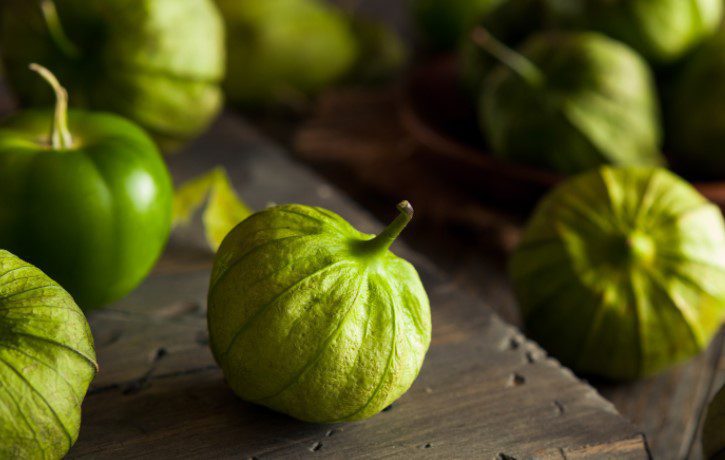Tomatillo
The tomatillo looks like a tomato. It tastes like a tomato that’s been sprinkled with lemon juice. Its name means “little tomato” in Spanish.
But even though its monikers include the husk tomato, Mexican green tomato, and the Chinese lantern plant (so-called for the husk’s resemblance to a Chinese hanging lantern), the tomatillo is not a tomato.
Like the tomato, the tomatillo is a fruit. The tomatillo, however, belongs to the physalis family and is thus related to the gooseberry and the ground cherry.
Native to Mexico, the tomatillo is a staple in Mexican cooking and figures largely in two of that cuisine’s traditional mole sauces: mole negro, the blackest of moles, as well as a mole Verde, or green sauce. Tomatillos are also grown in California and Texas.
Bite into a raw tomatillo, and you’ll discover a tart, faintly lemony flavor (though the taste can vary from tart to bitter, so a pinch of sugar is sometimes in order when adding it to sauces).
Select a tomatillo with a dry, tight-fitting husk with pale-green flesh underneath that is firm and unwrinkled. Tomatillos are generally green when ripe and are smaller, glossier, and firmer than a tomato, with sizes from half-inch to two inches.
While some varieties ripen to yellow or purple, the Toma Verde variety commonly found in U.S. markets remains green.
Tomatillos can be kept at room temperature for two days or placed in a paper bag and refrigerated for two to three weeks. (And like the tomato, tomatillos freeze well once they have been cooked in a sauce.)
When ready to use, peel the husk from the tomatillo, remove the stem and wash the tomatillo with cool water to remove the sticky, resinous material that it exudes from its stem.
Do not attempt to peel the fruit. If you will be using the tomatillo raw, cut it in half and remove the white core.
Tomatillos are the top ingredient in Mexican green salsas. Dice some and add them to your favorite recipes for salsa, guacamole, and gazpacho. Or add a handful to your favorite tossed salad.
Although tomatillos are often used raw, cooking brings out their faint apple flavor; cover whole tomatillos with water, bring to a simmer, and cook, covered, for about 10 minutes (careful not to let them burst).
Drain most but not all of the cooking liquid, add salt, mild green chilies, cilantro and onion, and jalapenos or other hot chilies to taste, simmer for about 20 minutes. You have a green sauce that can accompany enchiladas, tacos, tortilla chips, or nachos. Or drizzle it over grilled chicken, fish, or beef.
Stir in a bit of cream and simmer the sauce with some shrimp or scallops for a quick seafood stew.
And any traditional Mexican cook knows that the leftover cooking water can be added to masa when making tamales to produce a light and fluffy dough.
Tomatillo Recipe
BREAST OF CHICKEN & ROASTED TOMATILLO SAUCE
You can do the sauce before and store it covered in the refrigerator for up to three days.
- 3/4 lb tomatillos, husked (8 or so)
- 1 medium jalapeno, 2 serrano chilies
- 5 tablespoons olive oils, divided
- 1 cup chopped onions
- 1 tablespoon minced garlic
- 1 1/2 cups chicken broth
- 2 teaspoons brown sugar
- 1 cup minced cilantro leaves and tender stems, cut into pieces.
- 4 bone-in, skinless chicken breast halves (8-10 ounces)
Salt and freshly ground black pepper to taste
For garnish, use Crema (Mexican sour cream) or crumbled queso fresco, for garnish.
Lightly oil a baking sheet or pan with parchment paper.
Roast the tomatillos, jalapeno, or chilies in a hot oven for 3-4 minutes or until they become splotchy brown and have a few black marks.
Turn them over and roast the other side. Let cool, then transfer the tomatillos or chilies to the food processor fitted with a metal blade. Blend until smooth.
Heat 2 tablespoons of olive oil in a saucepan on medium heat. Stir in garlic and onions.
Cook for 6 minutes, until the garlic, is golden brown.
Turn heat up to medium-high.
Add tomatillo puree.
Cook for 3 min, or until sauce is thickened and darkens.
Add the broth, brown sugar, and 1/4 cup cilantro.
Turn the heat to low and stir covered for 10 minutes, or until sauce thickens—season with salt & pepper.
Place sauce aside
Season the chicken with salt and pepper in an oven-proof skillet large sufficient to hold the chicken in one layer, heat 3 tablespoons of olive oil on medium heat.
Cook the chicken skin-side bottom for 5 minutes, or until it is golden brown. Turn the chicken and cook the bone side for 2 minutes.
Take the chicken out of the pan. Bring to a boil the tomatillo sauce. Place chicken pieces skin-side up in the sauce. Bake for 15 minutes or until chicken is cooked.
A good method of checking if the chicken is well cooked, use a small knife to check near the bone.
In each of the four bowls, place one piece of chicken—spread sauce on top. Top with queso fresco or crema and garnish with remaining cilantro.
This makes 4 servings
406 calories per serving,
49 percent calories fat,
4 grams saturated,
113 mg cholesterol,
10g carbohydrates,
2 grams total fiber,
6 grams total sugars and 7 grams net carbs.
41 grams protein and 460 mg sodium


























